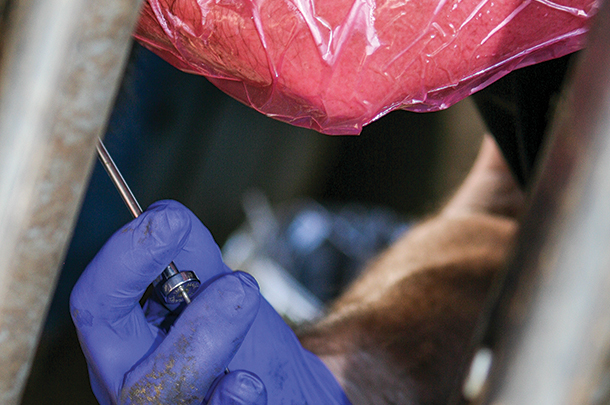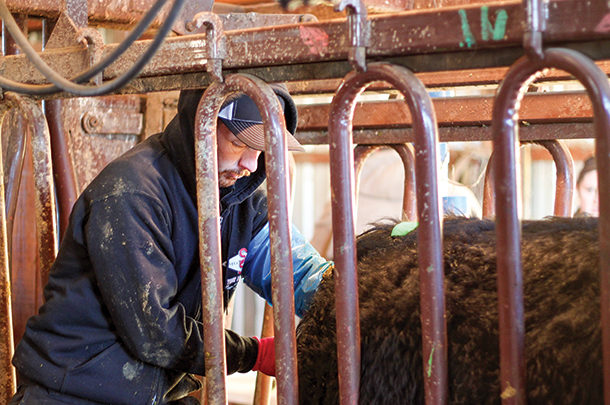One of the newer developments with A.I. in beef cattle is availability of sexed semen. Gender selection has been utilized for two decades in the dairy industry, and the number of beef bulls with sorted semen available from A.I. studs has increased during the past 10 years. The sexing service is provided by independent companies. The one doing it longest is STgenetics.
It is more expensive to produce sexed semen, and only about 25% of the sperm from a bull can be utilized. “Researchers have been trying to identify factors that impair sperm quality – to have less sperm damaged in sorting; in any ejaculate, the number of sperm cells left after sorting is greatly reduced, and some cells can’t be sorted,” says John Hall, Ph.D, an extension beef specialist with the University of Idaho’s Nancy M. Cummings Research, Extension and Education Center.
“About two years ago, ABS Global [one of the bull studs] got their own sorting system up and running,” Hall explains. “Their technology is different; they use a laser to inactivate sperm that carry the non-desired sex. They can knock out either the X or the Y sperm and the remainder will be the desired sex. The method utilized by STgenetics is to put dye on the semen, put the semen in droplets based on laser determination whether it is X or Y, then use an electrical charge to separate the semen.

“Over the years, STgenetics has improved pregnancy rates and number of calves with desired sex, but it’s never 100 percent. In our work, some years we had 89 percent, 92 percent, etc., but it’s usually about 90 percent. There will always be a few calves of the other sex.”
Situational use
Dr. David Bohnert, Eastern Oregon Agricultural Research Center at the Burns and Union stations for Oregon State University, says their research stations did trials with sexed semen from Genex a few years ago. “One challenge in the beef industry is that we don’t use A.I. as much as the dairy industry, and though there is work being done to make it better, conception rates are generally 10 to 20 percent less than when using regular semen,” he says.
A producer contemplating use of sexed semen should look at the whole picture – cost of semen, reduced conception rates and value of offspring. “There are advantages, especially for dairy producers who want heifers from their best cows. They can produce female calves from those cows and use beef semen (for male calves) on the others to get higher-value offspring,” says Bohnert.
“In our studies, we saw a difference in conception rates depending on method. Here at Burns, we used fixed-time A.I. and bred one group of cows with conventional semen and another group with sexed semen. We had a 20 percent reduction in pregnancy rate in cows bred with sexed semen compared with those bred with conventional semen. In the station at Union, we did heat detection prior to A.I., and in that situation sexed semen pregnancy rates were a little higher.” Pregnancy rates are better if the cow has shown estrus and is bred at the optimum time.
Depending on how you market calves, you might use sexed semen on your best cows to produce replacements using a good maternal bull. “For the rest of the cows, you could use a terminal sire (for male calves) or just use a good terminal sire cleanup bull, figuring to sell those offspring. This could minimize A.I. costs, just using sexed semen on a select group, knowing you’ll get mostly heifers from those,” says Bohnert.
The greatest value to most producers is for replacements. “If you were to sell those calves you’d just get market price, but to you those heifers will be worth more,” he says. Your best cows are the best source of replacements; they have the genetics you’ve worked toward and are adapted to your environment. Their heifer calves may be better than anything you could buy.
Changing ratios
Hall has been involved with sexed-semen research for a dozen years, breeding his first beef cows in 2008. “Over a large number of inseminations, we’ve been getting 48 to 50 percent pregnancy rates with fixed-time A.I. using sexed semen in post-partum cows. Our pregnancy rates with conventional semen averaged 58 percent,” says Hall.
“We’ve used X-sorted semen in a group of elite cows to produce replacement heifers. Our pregnancy rates are not as high as we’d like, but we’ve been able to change the heifer-to-bull ratio – with a single breeding with sexed semen, followed by natural service cleanup bulls – from a 50-50 herd ratio to about 65-35 or even 70-30 ratio,” he says. This assures a large group of heifer calves for replacements.
Sorting technology is continually being improved, and conception rates with sexed semen are also improving a little. “The company that does most of the sex sorting is now using what they call their SexedUltra 4M product, 4 million cells per straw, which is more than they originally had. They’ve also identified a group of sires with what they call ultra-fertility. Those sires work well with fixed-time A.I. and protocols with sexed semen,” says Hall.
One of the frustrations with sexed semen is that conception rates with fixed-time A.I. have not been as good as when doing heat detection. “Experiments at multiple universities have shown that the females coming into heat prior to the fixed-time A.I. have good pregnancy rates to sexed semen – 80 to 90 percent of what we get with conventional semen. Females that don’t respond usually do very poorly with sexed semen compared with conventional semen,” he explains.
“A group from Missouri led by Drs. David Patterson and Jordan Thomas came up with what they call split-time A.I. In this protocol, any females that have responded – by showing heat via use of a heat-detection patch – by the normal time with fixed-time A.I. are inseminated. In cows whose heat-detection patches have not been activated, we delay insemination for 24 hours. If a GnRH injection is given, we don’t give that shot to cows that did not respond. We wait and give it when we inseminate them 24 hours later,” says Hall. A fairly high percentage of cows that didn’t respond at first will respond in the next 24 hours, he explains.
The right candidates
Another management strategy is to use conventional semen on the ones that have not responded. There is a chance they will conceive to conventional semen. “Cows that don’t respond by the time of fixed-time A.I. [with poor chance for conception] usually have a 35 to 40 percent pregnancy rate with conventional semen, compared to 70 percent in the animals that have responded,” he says.
A.I. companies are finding that some bulls are better candidates for sexed semen than others. “There aren’t any tests that work on a regular basis for determining which bulls to select, but researchers are trying to find markers or tests that can be used after semen sorting to identify bulls whose semen is less damaged in the sorting,” says Hall.
To know if sexed semen would be of economic value, producers must evaluate their own situation. Bohnert says they got more steers (which is what they were aiming for in their trials), but the cows that did not conceive to sexed semen or conventional A.I. and were bred by a clean-up bull had calves that were younger and smaller.
“And if 50 percent are heifers, the advantage of using A.I. was reduced. It equaled out, with no difference in overall value of the calves. It wasn’t a negative result, but it wasn’t a benefit. We did not use sexed semen strategically (on certain cows), however, and I think this would make it most beneficial,” he says.
General cost
Prices per unit for sexed semen have come down, and more beef producers are using it, especially in purebred operations, says Hall. “There are not many commercial producers using it, but some use sexed semen on their best cows to produce replacement heifers, or use it on heifers. We’ve been using sexed semen to create heifers from first-calf heifers.”
One challenge for commercial producers is that there’s less genetic information to help you make selections (expected progeny differences, genomics, etc.) on a commercial heifer than a purebred heifer. Creating heifers out of heifers serves two purposes: calves will be smaller at birth and born easier, and if they have the desired genetics, they make good cows.
“This reduces generation intervals. Normally you wouldn’t keep a heifer from a cow until you know she’s a really good cow. She might be 5 or 6 before you keep a heifer from her to replace her,” Hall says. Usually a producer breeds all heifers to a good “heifer bull,” but that bull may not be the best to sire replacement heifers.
“One thing that has limited our progress in beef cow herd improvement is what we call generation interval. If we can keep replacement heifers out of heifers, this shortens those intervals,” he explains. ![]()
PHOTO 1: To know the economic value of sexed semen, producers must evaluate their situation and their herd candidates.
PHOTO 2: Prices per unit for sexed semen have gone down, encouraging more usage among beef producers. Photos courtesy of Willie Altenburg, Select Sires.
Heather Smith Thomas is a freelance writer based in Idaho.










